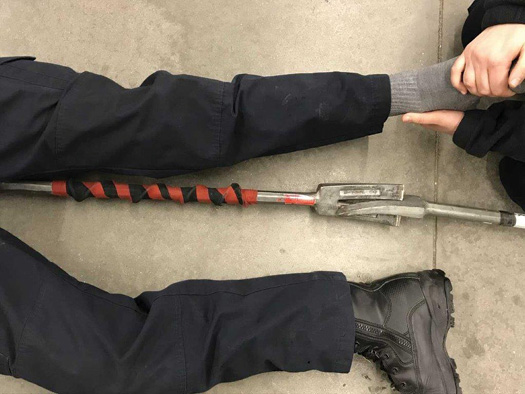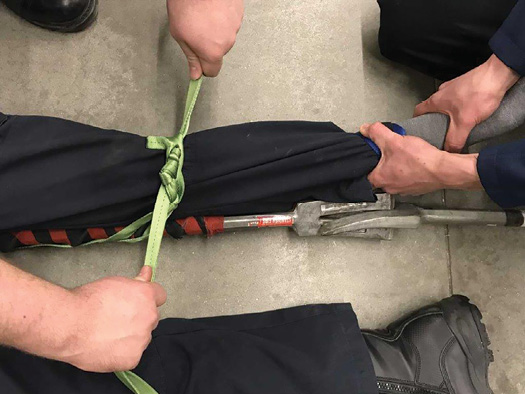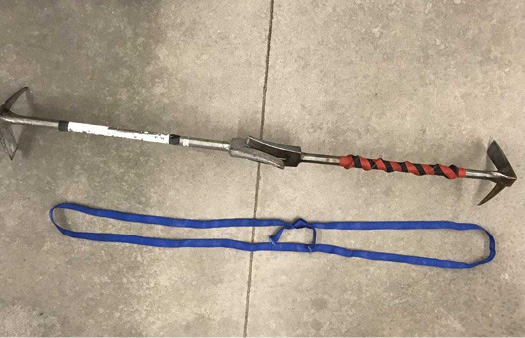
By BRIAN POND
Scenario: You are tasked with teaching an emergency medical services (EMS) drill on splinting to your crew. As you attempt to devise scenarios for the training, you ask yourself, “How am I going to get the crew to take this seriously? What if they get bored? Will the training be effective?” These thoughts can be intimidating for any instructor; it’s a challenge all instructors face. However, there are ways you can increase the effectiveness of EMS training. Sometimes, all it takes is a little thinking outside the box.




(1-6) Crews from Standish (ME) Fire/EMS perform the traction splinting drill. (Photos courtesy of author.)
The Instructor’s Challenge
We have all stood in front of a classroom trying to bring the crew’s focus back to the task at hand. You may notice a few members watch one person perform the skill, and then they slowly begin a separate conversation. This becomes a distraction for the instructor and the class participants.
This dilemma is magnified when medical training is thrown into the mix and you find yourself wasting precious time trying to refocus individuals rather than teaching the objectives. Many firefighters become uninterested quickly when they are not being challenged. As instructors, it is our responsibility to find ways to engage even the most senior crew members.
I have had success in creating a challenge to students in the application portion of the drill. By creating a challenge, you give the crew a common goal to reach, which will keep their interest throughout the training evolution. The challenge should be something they can accomplish only through teamwork, requiring participation from the whole group. While they are engaged in the challenge at hand, the instructor can focus on presenting the learning objectives without the distraction of an uninterested audience. Following is an example of a splinting drill that incorporates this technique:
• Lesson title: Traction Splinting Skills.
• Objective: To assess and splint an isolated closed femur fracture to emergency medical technician (EMT) skills sheet standards using only the equipment provided.
• Equipment Needed: Two halligan bars, two one-inch pieces of webbing, a 50-foot rope bag, one unipolar traction splint, and one bipolar traction splint.
• Preparation: Submit appropriate paperwork for continuing education hours. When a crew does not receive credit for training, the instructor and training division may lose credibility.

- • Presentation:
- • Application:
- • Evaluation:
- • Teaching Notes:
This drill is limited only by your imagination. You can use this training model for other EMS drills easily. For example, use it for a backboarding drill using two pike poles and webbing to immobilize a patient.
Additional Drill Ideas
Do not allow students to get stuck on the idea of the slim chance they have of ever using this equipment for a femur fracture; they should focus on their ability to perform the skill while in an adverse situation. This is similar to the “Gentle Extrication Drill,” where students used a spreader to pick up an egg at one cone and placed it on another cone. The goal is proficiency with the tool or, in this case, the medical skill.
You can also use this drill as a multipart series. Part One can be a short lecture followed by basic traction splinting. Part Two can be advanced splinting, using the parameters above to increase the level of difficulty of the skill. You can also create a full-day splinting program. In a full-day format, the class could have short lectures of different splinting techniques followed by practical skill stations.
Conducting a drill in this manner allows instructors to engage their audiences and improve the effectiveness of training. By avoiding “death by slide show,” instructors increase not only retention of the material but also attendance at future training as well.
BRIAN POND is the training officer for Standish (ME) Fire/EMS. He has 16 years of fire service experience, the past 10 as a paramedic. He is also a paramedic instructor for United Ambulance Service and a lead instructor for the Presumpscot Valley (ME) Fire Academy.


